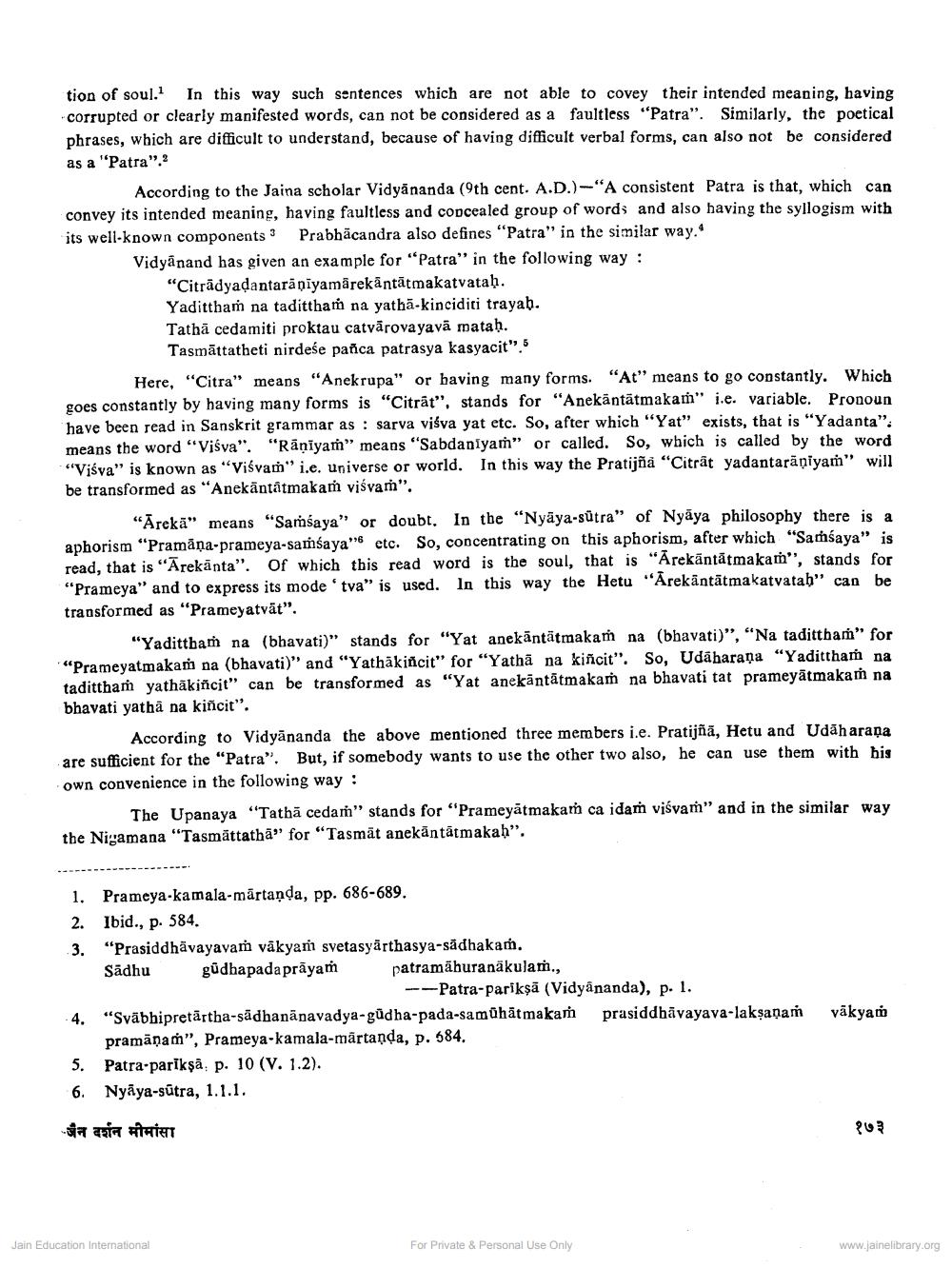________________
tion of soul. In this way such sentences which are not able to covey their intended meaning, having corrupted or clearly manifested words, can not be considered as a faultless "Patra". Similarly, the poetical phrases, which are difficult to understand, because of having difficult verbal forms, can also not be considered as a 'Patra".
According to the Jaina scholar Vidyānanda (9th cent. A.D.)-"A consistent Patra is that, which can convey its intended meaning, having faultless and concealed group of words and also having the syllogism with its well-known components 3 Prabhācandra also defines "Patra" in the similar way.
Vidyānand has given an example for "Patra" in the following way :
"Citrādyadantarāņiyamārekāntātmakatvataḥ. Yadittham na tadittham na yatha-kinciditi trayah. Tathä сedamiti proktau catvārovayavā matah.
Tasmāttatheti nirdese panca patrasya kasyacit".
Here, "Citra" means "Anekrupa" or having many forms. "At" means to go constantly. Which goes constantly by having many forms is "Citrāt", stands for "Anekäntätmakan" i.e. variable. Pronoun have been read in Sanskrit grammar as : sarva viśva yat etc. So, after which "Yat" exists, that is "Yadanta". means the word "Viśva". "Rāņiyam” means "Sabdaniyam” or called. So, which is called by the word "Viśva" is known as "Visvam" i.e. universe or world. In this way the Pratijña "Citrat yadantarāņiyam" will be transformed as "Anekāntâtmakam visvam".
“Ārekā” means "Sambaya” or doubt. In the "Nyāya-sútra” of Nyāya philosophy there is a aphorism "Pramāņa-prameya-samsaya" etc. So, concentrating on this aphorism, after which "Sambaya" is read, that is "Arekānta". Of which this read word is the soul, that is "Ārekāntātmakam", stands for “Prameya" and to express its mode 'tva” is used. In this way the Hetu "Ārekāntātmakatvatah” can be transformed as "Prameyatvāt".
"Yadittham na (bhavati)" stands for "Yat anekāntätmakam na (bhavati)", "Na tadittham" for "Prameyatmakaṁ na (bhavati)" and "Yathākiñcit" for "Yathā na kiñcit". So, Udaharana "Yadittham na tadittham yathäkincit" can be transformed as "Yat anekāntātmakam na bhavati tat prameyatmakam na bhavati yathā na kiñcit".
According to Vidyānanda the above mentioned three members i.e. Pratijfiä, Hetu and Udāh arapa are sufficient for the "Patra". But, if somebody wants to use the other two also, he can use them with his own convenience in the following way :
The Upanaya "Tathā cedam" stands for "Prameyatmakam ca idam viśvam" and in the similar way the Nigamana "Tasmāttathā” for "Tasmät anekāntátmakah".
1. Prameya-kamala-mārtanda, pp. 686-689. 2. Ibid., p. 584. 3. "Prasiddhävayavam vākyam svetasyārthasya-sädhakam. Sadhu güdhapada prāyam patramähuranäkulam.,
--Patra-pariksā (Vidyānanda), p. 1. "Svābhipretărtha-sādhanänavadya-gūdha-pada-samühātmakam prasiddhāvayava-laksanam
pramānam”, Prameya-kamala-märtanda, p. 584. 5. Patra-pariksa p. 10 (V. 1.2). 6. Nyāya-sútra, 1.1.1.
vākyan
जैन दर्शन मीमांसा
१७३
Jain Education International
For Private & Personal Use Only
www.jainelibrary.org




